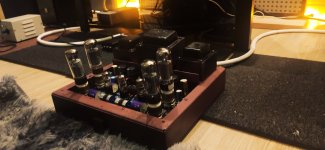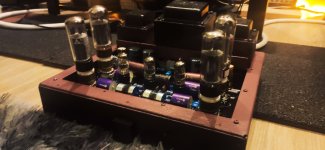Agreed and I would not. However a good modern 6550 operated well within max power dissipation may be OK. 50K does cause problems with drivers.
I don't know why the KT88 is better in this respect they are very similar construction. I have not seen any grid leakage measurements but would love to see some.
Hammond do a good range of cheap OPT's which have good LF and HF responses. Digikey have them.
I don't know why the KT88 is better in this respect they are very similar construction. I have not seen any grid leakage measurements but would love to see some.
Hammond do a good range of cheap OPT's which have good LF and HF responses. Digikey have them.
As for the grid resistors : read the spec's :Agreed and I would not. However a good modern 6550 operated well within max power dissipation may be OK. 50K does cause problems with drivers.
I don't know why the KT88 is better in this respect they are very similar construction. I have not seen any grid leakage measurements but would love to see some.
Hammond do a good range of cheap OPT's which have good LF and HF responses. Digikey have them.
https://frank.pocnet.net/sheets/084/k/KT88_GEC.pdf
https://frank.pocnet.net/sheets/163/k/KT88.pdf
a couple of ideas for you. since the OPT is toast, pull it out and
a) try to "look" inside, there might be a blown fuse (resistance = open)
b) contact a trafo rebuilder (Heyboer) and have them fix or build you
one.
all audio gear should be salvaged.
Bob
a) try to "look" inside, there might be a blown fuse (resistance = open)
b) contact a trafo rebuilder (Heyboer) and have them fix or build you
one.
all audio gear should be salvaged.
Bob
a couple of ideas for you. since the OPT is toast, pull it out and
a) try to "look" inside, there might be a blown fuse (resistance = open)
b) contact a trafo rebuilder (Heyboer) and have them fix or build you
one.
all audio gear should be salvaged.
Bob
Hi Bob
The primaries and secondaries are dead shorted. I have contacted a couple of trafo builders in the UK who said they couldn't make one, though I only mentioned the make and model.
There is a very good tech in my area, when all this craziness ends I might get him to have a look, measure the good one ( I only have a meter ) and go from there.
I think there is an issue in the amp that caused this other than a faulty valve since the corresponding valve V5 on the other channel was also burning out the screen resistor. The bias was correct. Am I correct in thinking the screen resistors should be wire wound not carbon ?
I had an ARC 30 years ago, I should have learned from that..
Mark
if it's a dead short then sometimes its at the end of the windings where the
taps are - uncovering and possibly unwinding a few turns may expose the
short.
if all the secondaries are shorted then there may be some other structural
problem with the trafo. ?perhaps the shielding?
if all primary and secondary taps are shorted then I'd look for a trafo
winder for him to look into the unit. he may be able to count the turns
or redesign the necessary voltages and rewind each section.
if the unit is important to you, you may wish to consider an external power
supply and cable all the voltages into the vt60 and design the external
unit to supply the necessary voltages.
bob
taps are - uncovering and possibly unwinding a few turns may expose the
short.
if all the secondaries are shorted then there may be some other structural
problem with the trafo. ?perhaps the shielding?
if all primary and secondary taps are shorted then I'd look for a trafo
winder for him to look into the unit. he may be able to count the turns
or redesign the necessary voltages and rewind each section.
if the unit is important to you, you may wish to consider an external power
supply and cable all the voltages into the vt60 and design the external
unit to supply the necessary voltages.
bob
Its worth looking at the Hammond 1650NA or 1650PA. I don't know what you primary impedance needs to be but I think turns ratio is about 15:1 so maybe the 1650NA.
If the current has been flowing for a while (which is sounds its has) then the windings will have fused together.
If the current has been flowing for a while (which is sounds its has) then the windings will have fused together.
Its worth looking at the Hammond 1650NA or 1650PA. I don't know what you primary impedance needs to be but I think turns ratio is about 15:1 so maybe the 1650NA.
If the current has been flowing for a while (which is sounds its has) then the windings will have fused together.
Yes i looked at those. I messaged appme, when he finally builds his VT60 clone - at first glance the circuit looks identical. I need to get accurate measurements of the good one. Still need to get to the bottom of why those two positions are drawing excessive current. I guess this is the result of no fuses on B+..
if it's a dead short then sometimes its at the end of the windings where the
taps are - uncovering and possibly unwinding a few turns may expose the
short.
if all the secondaries are shorted then there may be some other structural
problem with the trafo. ?perhaps the shielding?
if all primary and secondary taps are shorted then I'd look for a trafo
winder for him to look into the unit. he may be able to count the turns
or redesign the necessary voltages and rewind each section.
if the unit is important to you, you may wish to consider an external power
supply and cable all the voltages into the vt60 and design the external
unit to supply the necessary voltages.
I haven't had it that long, my business is non existent until all this is over so I'd rather repair than write it off. If I do manage to find a transformer ( or two for a match if they are different ), I still need to find out why it's happening only on one corresponding valve on both channels, I replaced the screen resistors a few months back on the same two. Although the other trafo is ok it had burnt out the same resistor. It seems an unlikely coincidence that the same two positions had faulty valves after replacement.
bob
Its worth looking at the Hammond 1650NA or 1650PA. I don't know what you primary impedance needs to be but I think turns ratio is about 15:1 so maybe the 1650NA.
If the current has been flowing for a while (which is sounds its has) then the windings will have fused together.
I think this is likely - it was cooking just before it blew fuse.
- Home
- Amplifiers
- Tubes / Valves
- ARC VT60

